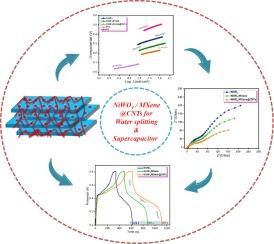Probing the synergistic effect of MXene (Ti3C2Tx) and MWCNTs on NiWO4 for superior water-splitting and supercapacitor studies
IF 7.5
1区 工程技术
Q2 ENERGY & FUELS
引用次数: 0
Abstract
The main focus of the ongoing worldwide research is the production and storage of green energy via electrochemical study. MXene (2D) and multi-walled carbon nanotubes (MWCNTs (1D)) play enormous roles in enhancing the efficiency of nanomaterials for electrochemical measurements. A wet chemical approach is employed to synthesize NiWO4. The nanocomposite of NiWO4 with MXene and MWCNTs is prepared via ultrasonication approach. Structural, morphological and elemental aspects of the prepared samples are investigated via different characterization techniques. Hydrogen and oxygen evolution reactions are performed in an alkaline solution. NiWO4/MXene@CNTs shows Tafel slope of 77 and 91 mV/dec for HER and OER, respectively. Supercapacitor performance is evaluated via cyclic voltammetry (CV) and galvanostatic charge–discharge (GCD) experiments. The current response shown by the materials is best analyzed through CV measurements. NiWO4/MXene@CNTs composite exhibits discharge time of 500 s as compared to NiWO4 (276 s) and NiWO4/MXene (390 s). NiWO4/MXene@CNTs composite shows specific capacitance and retention of 1250 F/g and 80 %, respectively. The resistance faced by the materials during electrochemical measurements is analyzed using electrochemical impedance spectroscopy. MXene and MWCNTs boost the efficiency of NiWO4 via synergistic effect and make it a potential material for water splitting and supercapacitor study.

探讨MXene (Ti3C2Tx)和MWCNTs在NiWO4上的协同作用,以获得更好的水分解和超级电容器研究
目前世界范围内研究的主要焦点是通过电化学研究生产和储存绿色能源。MXene (2D)和多壁碳纳米管(MWCNTs (1D))在提高纳米材料在电化学测量中的效率方面发挥着巨大的作用。采用湿化学法合成NiWO4。采用超声法制备了NiWO4 - MXene和MWCNTs纳米复合材料。通过不同的表征技术研究了所制备样品的结构、形态和元素方面。氢和氧的析出反应在碱性溶液中进行。NiWO4/MXene@CNTs显示HER和OER的Tafel斜率分别为77和91 mV/dec。通过循环伏安法(CV)和恒流充放电(GCD)实验对超级电容器的性能进行了评价。材料所显示的电流响应最好通过CV测量来分析。与NiWO4 (276 s)和NiWO4/MXene (390 s)相比,NiWO4/MXene@CNTs复合材料的放电时间为500 s, NiWO4/MXene@CNTs复合材料的比电容和保持率分别为1250 F/g和80%。利用电化学阻抗谱分析了材料在电化学测量过程中所面临的电阻。MXene和MWCNTs通过协同效应提高了NiWO4的效率,使其成为一种潜在的水分解和超级电容器研究材料。
本文章由计算机程序翻译,如有差异,请以英文原文为准。
求助全文
约1分钟内获得全文
求助全文
来源期刊

Fuel
工程技术-工程:化工
CiteScore
12.80
自引率
20.30%
发文量
3506
审稿时长
64 days
期刊介绍:
The exploration of energy sources remains a critical matter of study. For the past nine decades, fuel has consistently held the forefront in primary research efforts within the field of energy science. This area of investigation encompasses a wide range of subjects, with a particular emphasis on emerging concerns like environmental factors and pollution.
 求助内容:
求助内容: 应助结果提醒方式:
应助结果提醒方式:


